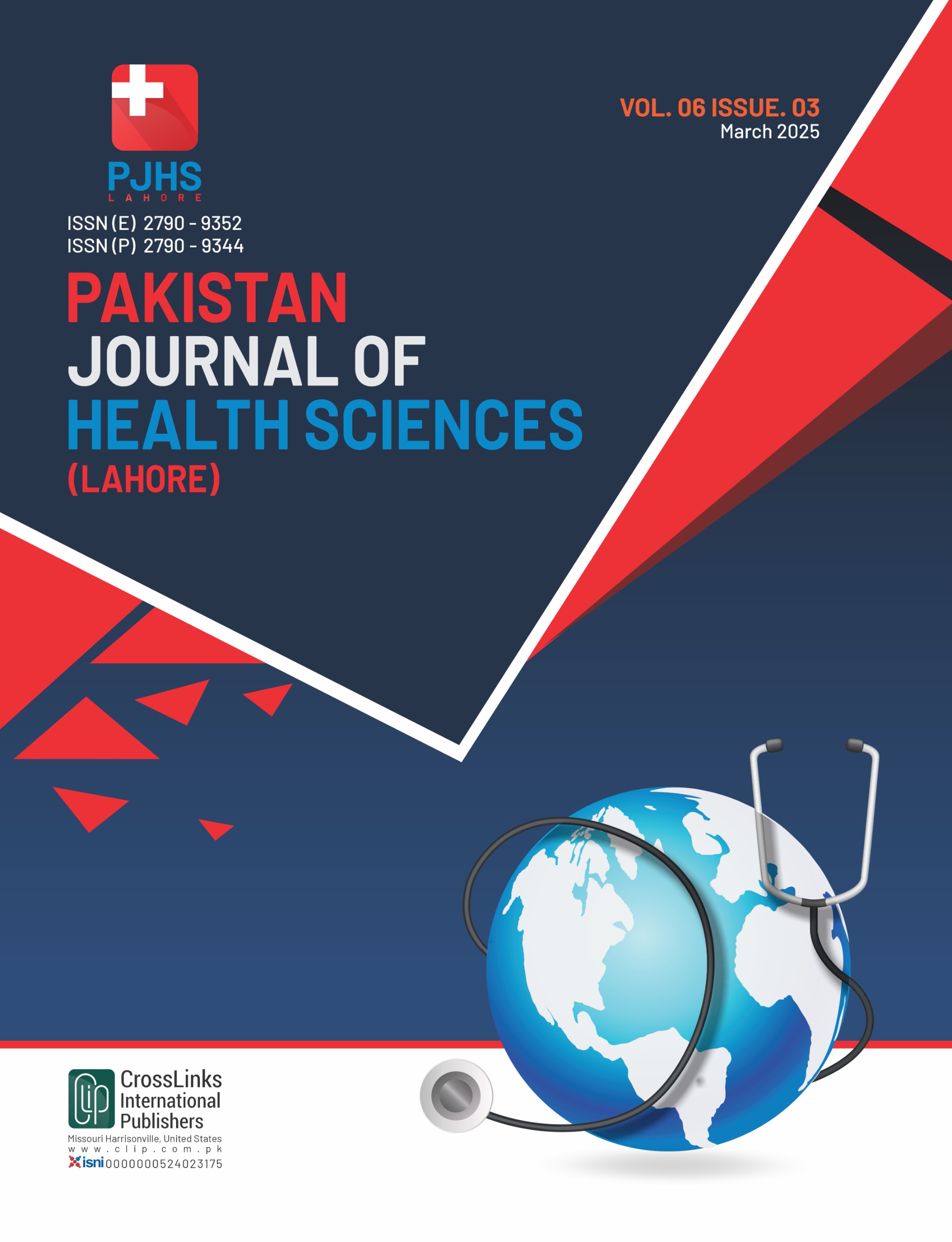Screening Student Behavior: Exploring the Impact of Daily Screen Time on Sleep Quality, Mental Distress, and Academic Performance in Students
Screening Student Behavior
DOI:
https://doi.org/10.54393/pjhs.v6i3.2745Keywords:
Screen Time, Mental Health, Sleep Quality, Depression, Academic PerformanceAbstract
The pervasive influence of technology, particularly screen usage, on daily routines and its implications for sleep quality, mental health, academic performance, and physical activity has become an increasing area of concern. Objective: To evaluate the daily screen time of students from different fields of study and to assess its association with demographic variables, sleep quality, psychological symptoms, physical activity, and academic performance. Methods: This study was performed at Isra University, Hyderabad from February 2024 to August 2024, with 152 participants. Data on demographics, sleep quality (PSQI), mental distress (DASS-42), academic performance, and screen time were collected after informed consent. Statistical analysis, conducted using SPSS version 25.0, determined correlations between daily screen time, PSQI, and DAS scores. Results: The participants had a mean age of 20.59 ± 2.16 years, with most residing in urban areas (87.5%) and being day scholars (74.34%). Average daily screen time was 5.85 ± 1.14 hours, significantly higher among those with GPAs below 2.5 and low physical activity levels (p<0.05). Mean scores for depression, anxiety, stress, and PSQI were 13.34 ± 12.01, 11.17 ± 9.41, 15.32 ± 11.09, and 6.45 ± 3.48, respectively. Screen time positively correlated with depression (r = 0.81, p<0.01), anxiety (r = 0.78, p<0.01), stress (r = 0.83, p<0.01), and PSQI (r = 0.75, p<0.01). Conclusion: Increased screen time was linked to poorer sleep quality, elevated mental distress, and reduced academic performance, particularly in urban populations and individuals using screens for recreation.
References
Wang X, Li Y, Fan H. The associations between screen time-based sedentary behavior and depression: a systematic review and meta-analysis. BMC public health. 2019;19:1-9. https://doi.org/10.1186/s12889-019-7904-9 DOI: https://doi.org/10.1186/s12889-019-7904-9
Uqaili A, Qaiser F, Abbas K, Rahman AA. Smartphone use among young doctors and their impact on patients of Liaquat University Hospital Jamshoro. Imp J Interdiscip Res(IJIR). 2017;3:161-4.
Lee L, Nam OH, Lee KE, Lee C. Relationship between insomnia and working from home among Korean domestic workers: results from the 5th Korean working condition survey. BMC Public Health. 2023;23(1):1367. https://doi.org/10.1186/s12889-023-16268-5 DOI: https://doi.org/10.1186/s12889-023-16268-5
Ejaz W, Altay S, Naeem G. Smartphone use and well-being in Pakistan: Comparing the effect of self-reported and actual smartphone use. Digital Health. 2023;9:20552076231186075. https://doi.org/10.1177/20552076231186075 DOI: https://doi.org/10.1177/20552076231186075
Li L, Zhang Q, Zhu L, Zeng G, Huang H, Zhuge J, et al. Screen time and depression risk: A meta-analysis of cohort studies. Frontiers in Psychiatry. 2022;13:1058572. https://doi.org/10.3389/fpsyt.2022.1058572 DOI: https://doi.org/10.3389/fpsyt.2022.1058572
Al-Khani AM, Sarhandi MI, Zaghloul MS, Ewid M, Saquib N. A cross-sectional survey on sleep quality, mental health, and academic performance among medical students in Saudi Arabia. BMC research notes. 2019;12(1):1-5. https://doi.org/10.1186/s13104-019-4713-2 DOI: https://doi.org/10.1186/s13104-019-4713-2
Nakshine VS, Thute P, Khatib MN, Sarkar B. Increased screen time as a cause of declining physical, psychological health, and sleep patterns: a literary review. Cureus. 2022;14(10). https://doi.org/10.7759/cureus.30051 DOI: https://doi.org/10.7759/cureus.30051
Hosen MJ, Eva SA, Rahman MM, Ibrahim M, Lira UF, Hossain AB, et al. Health impacts of excessive use of Facebook among university students in Bangladesh. Heliyon. 2021;7(6). https://doi.org/10.1016/j.heliyon.2021.e07271 DOI: https://doi.org/10.1016/j.heliyon.2021.e07271
Santos RMS, Mendes CG, Sen Bressani GY, de Alcantara Ventura S, de Almeida Nogueira YJ, de Miranda DM, et al. The associations between screen time and mental health in adolescents: a systematic review. BMC psychology. 2023;11(1):1-21. https://doi.org/10.1186/s40359-023-01166-7 DOI: https://doi.org/10.1186/s40359-023-01166-7
Lissak G. Adverse physiological and psychological effects of screen time on children and adolescents: Literature review and case study. Environmental research. 2018;164:149-57. https://doi.org/10.1016/j.envres.2018.01.015 DOI: https://doi.org/10.1016/j.envres.2018.01.015
Lemola S, Perkinson-Gloor N, Brand S, Dewald-Kaufmann JF, Grob A. Adolescents’ Electronic Media Use at Night, Sleep Disturbance, and Depressive Symptoms in the Smartphone Age. Journal of Youth and Adolescence. 2015;44(2):405-18. https://doi.org/10.1007/s10964-014-0176-x DOI: https://doi.org/10.1007/s10964-014-0176-x
Nedjar-Guerre A, Wattelez G, Serra-Mallol C, Frayon S, Galy O. Adolescent screen time and unhealthy food consumption in the context of the digital development in New Caledonia. Plos one. 2023;18(5):e0285374. https://doi.org/10.1371/journal.pone.0285374 DOI: https://doi.org/10.1371/journal.pone.0285374
Varadarajan S, Govindarajan Venguidesvarane A, Ramaswamy KN, Rajamohan M, Krupa M, Winfred Christadoss SB. Prevalence of excessive screen time and its association with developmental delay in children aged< 5 years: A population-based cross-sectional study in India. Plos one. 2021;16(7):e0254102. https://doi.org/10.1371/journal.pone.0254102 DOI: https://doi.org/10.1371/journal.pone.0254102
Wang H, Zhong J, Hu R, Fiona B, Yu M, Du H. Prevalence of high screen time and associated factors among students: a cross-sectional study in Zhejiang, China. BMJ open. 2018;8(6). https://doi.org/10.1136/bmjopen-2018-021493 DOI: https://doi.org/10.1136/bmjopen-2018-021493
Whiting S, Buoncristiano M, Gelius P, Abu-Omar K, Pattison M, Hyska J, et al. Physical activity, screen time, and sleep duration of children aged 6–9 years in 25 countries: An analysis within the WHO European childhood obesity surveillance initiative (COSI) 2015–2017. Obesity facts. 2021;14(1):32-44. https://doi.org/10.1159/000511263 DOI: https://doi.org/10.1159/000511263
O’Brien W, Belton S, Fitzpatrick B, Shannon S, Brennan D, Chambers F, et al. Relationship between gender, physical activity, screen time, body mass index and wellbeing in Irish children from social-disadvantage. Child Care in Practice. 2021:1-15. https://doi.org/10.1080/13575279.2021.1887815 DOI: https://doi.org/10.1080/13575279.2021.1887815
O’Brien W, Issartel J, Belton S. Relationship between physical activity, screen time and weight status among young adolescents. Sports. 2018;6(3):57. https://doi.org/10.3390/sports6030057 DOI: https://doi.org/10.3390/sports6030057
Maurya C, Muhammad T, Maurya P, Dhillon P. The association of smartphone screen time with sleep problems among adolescents and young adults: cross-sectional findings from India. BMC Public Health. 2022;22(1):1686. https://doi.org/10.1186/s12889-022-14076-x DOI: https://doi.org/10.1186/s12889-022-14076-x
Adamczewska-Chmiel K, Dudzic K, Chmiela T, Gorzkowska A. Smartphones, the epidemic of the 21st century: a possible source of addictions and neuropsychiatric consequences. International Journal of Environmental Research and Public Health. 2022;19(9):5152. https://doi.org/10.3390/ijerph19095152 DOI: https://doi.org/10.3390/ijerph19095152
Zhang J, He M, Wang X, Jiang H, Huang J, Liang S. Association of sleep duration and risk of mental disorder: a systematic review and meta-analysis. Sleep and Breathing. 2023:1-20. https://doi.org/10.1007/s11325-023-02905-1 DOI: https://doi.org/10.1007/s11325-023-02905-1
Guerrero MD, Barnes JD, Chaput J-P, Tremblay MS. Screen time and problem behaviors in children: exploring the mediating role of sleep duration. International Journal of Behavioral Nutrition and Physical Activity. 2019;16(1):1-10. https://doi.org/10.1186/s12966-019-0862-x DOI: https://doi.org/10.1186/s12966-019-0862-x
Korcz A, Krzysztoszek J, Bronikowski M, Łopatka M, Bojkowski Ł. Associations between physical activity, screen time, sleep time and selected academic skills in 8/9-year-old children. BMC Public Health. 2023;23(1):1335. https://doi.org/10.1186/s12889-023-16230-5 DOI: https://doi.org/10.1186/s12889-023-16230-5
Dubey M, Nongkynrih B, Gupta SK, Kalaivani M, Goswami AK, Salve HR. Sleep quality assessment of adolescents residing in an urban resettlement colony, New Delhi, India. Indian journal of community medicine: official publication of Indian Association of Preventive & Social Medicine. 2019;44(3):271. https://doi.org/10.4103/ijcm.IJCM_87_19 DOI: https://doi.org/10.4103/ijcm.IJCM_87_19
Boers E, Afzali MH, Newton N, Conrod P. Association of screen time and depression in adolescence. JAMA pediatrics. 2019;173(9):853-9. https://doi.org/10.1001/jamapediatrics.2019.1759 DOI: https://doi.org/10.1001/jamapediatrics.2019.1759
Ma L, Evans B, Kleppang AL, Hagquist C. The association between screen time and reported depressive symptoms among adolescents in Sweden. Family practice. 2021;38(6):773-9. https://doi.org/10.1093/fampra/cmab029 DOI: https://doi.org/10.1093/fampra/cmab029
Sampasa-Kanyinga H, Colman I, Goldfield GS, Janssen I, Wang J, Podinic I, et al. Combinations of physical activity, sedentary time, and sleep duration and their associations with depressive symptoms and other mental health problems in children and adolescents: a systematic review. International Journal of Behavioral Nutrition and Physical Activity. 2020;17(1):1-16. https://doi.org/10.1186/s12966-020-00976-x DOI: https://doi.org/10.1186/s12966-020-00976-x
Sapci O, Elhai JD, Amialchuk A, Montag C. The relationship between smartphone use and students` academic performance. Learning and Individual Differences. 2021;89:102035. https://doi.org/10.1016/j.lindif.2021.102035 DOI: https://doi.org/10.1016/j.lindif.2021.102035
Hadianfard AM, Mozaffari-Khosravi H, Karandish M, Azhdari M. Physical activity and sedentary behaviors (screen time and homework) among overweight or obese adolescents: a cross-sectional observational study in Yazd, Iran. BMC pediatrics. 2021;21:1-10. https://doi.org/10.1186/s12887-021-02892-w DOI: https://doi.org/10.1186/s12887-021-02892-w
Downloads
Published
How to Cite
Issue
Section
License
Copyright (c) 2025 Pakistan Journal of Health Sciences

This work is licensed under a Creative Commons Attribution 4.0 International License.
This is an open-access journal and all the published articles / items are distributed under the terms of the Creative Commons Attribution License, which permits unrestricted use, distribution, and reproduction in any medium, provided the original author and source are credited. For comments













